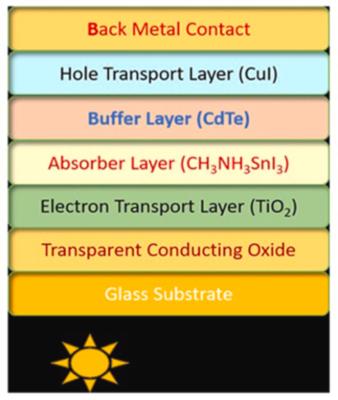Researchers from Pakistan's University of Agriculture Faisalabad, University College of London United Kingdom and The National University of Malaysia have conducted a series of simulations to investigate how a cadmium telluride buffer layer (BL) may help increase efficiency and stability in perovskite solar cells. Their experiment showed that cell efficiency may climb from 11.09% to 23.56%.
Solar cell architecture with BL. Image credit: Results in Engineering
The researchers explained that the presence of a BL in a perovskite cell offers a porous structure that aids in forming the upper hole-transporting layer (HTL), while also preventing the leakage of corrosive additives from the HTL material. “The improvement in the development of HTM layer not only promotes efficient hole transfer and conduction but also restricts charge recombination,” they explained.
The team chose to use CdTe due to the hypotheses that its hydrophobic nature could protect the absorber from moisture and corrosion, and that its high UV resistance could minimize UV-induced degradation, enhancing cell stability.
The scientists used the SCAPS-1D solar cell capacitance software, developed by the University of Ghent, to simulate the novel cell configuration. The device was based on a substrate made of glass, a transparent conductive oxide (TCO), an electron transport layer (ETL) made of titanium oxide (TiO2), an absorber made of a perovskite material known as CH3NH3SnI3, the CdTe buffer layer, an HTL made of Copper(I) iodide (Cul), and a back metal contacts.
The performance of this device was simulated under standard illumination conditions and compared to that of a reference device without a buffer layer. The CdTe-based cell achieved a power conversion efficiency of 14.76%, an open-circuit voltage of 0.83 V, a short-circuit current density of 25.96 mA/cm2, and a fill factor of 68.42%. The benchmark device achieved an efficiency of 11.09%, an open-circuit voltage of 0.69 V, a short-circuit current density of 26.22 mA/cm2, and a fill factor of 61.46%.
By further fine-tuning the thickness of the buffer layer and improving the material composition of the perovskite absorber and the ETL, the scientists could improve significantly the cell efficiency during the simulation. “These optimized device parameters showed a significant enhancement in device performance with the CdTe layer at CuI/CH3NH3SnI3 interface, resulting in the efficiency of 23.56% compared to 11.09% without the BL,” they explained.
“The findings demonstrate that the incorporation of CdTe significantly enhances the power conversion efficiency of n-i-p device,” the group concluded.




